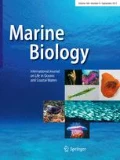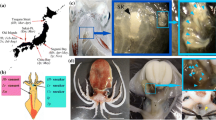Abstract
Simultaneous hermaphrodites experience unique conflicts of interest during reproduction, some of which are reflected in their complex mating behaviours. We here provide the first detailed description of the mating behaviour of a marine flatworm of the genus Macrostomum, a cosmopolitan group of microturbellaria. Mating in this species is usually initiated by the precopulatory behaviours circling and reeling, then leads to reciprocal copulation where worms mutually insert their copulatory stylet, and often ends in an intriguing postcopulatory sucking behaviour. We provide detailed data on the frequencies and durations of the different behaviours, and examine some biotic and abiotic factors that could influence the mating rate. We further speculate on the function of sucking and suggest that it could be an adaptation for the digestion of sperm and/or the removal of seminal components, which may function as allohormones.





Similar content being viewed by others
References
Apelt G (1969) Fortpflanzungsbiologie, Entwicklungszyklen und vergleichende Frühentwicklung acoeler Turbellarien. Mar Biol 4:267–325
Ax P, Borkott H (1968) Organisation und Fortpflanzung von Macrostomum romanicum (Turbellaria, Macrostomida). Institut für den wissenschaftlichen Film, Göttingen
Baur B (1998) Sperm competition in molluscs. In: Birkhead TR, Møller AP (eds) Sperm competition and sexual selection. Academic, London, pp 255–305
Bojat NC, Sauder U, Haase M (2001) The spermathecal epithelium, sperm and their interactions in the hermaphroditic land snail Arianta arbustorum (Pulmonata, Stylommatophora). Zoomorphology 120:149–157
Bresslau E (1928) Turbellaria. Walter de Gruyter, Berlin
Chapman T, Liddle LF, Kalb JM, Wolfner MF, Partridge L (1995) Cost of mating in Drosophila melanogaster females is mediated by male accessory gland products. Nature 373:241–244
Charnov EL (1979) Simultaneous hermaphroditism and sexual selection. Proc Natl Acad Sci 76:2480–2484
Costello HM, Costello DP (1938) Copulation in the acoelous turbellarian Polychoerus carmelensis. Biol Bull (Woods Hole) 75:85–98
Doe DA (1982) Ultrastructure of copulatory organs in Turbellaria. 1. Macrostomum sp. and Microstomum sp. (Macrostomida). Zoomorphology 101:39–60
Faubel A, Blome D, Cannon LRG (1994) Sandy beach meiofauna of eastern Australia (southern Queensland and New South Wales). 1. Introduction and Macrostomida (Platyhelminthes). Invertebr Taxon 8:989–1007
Fischer EA (1980) The relationship between mating system and simultaneous hermaphroditism in the coral reef fish, Hypoplectrus nigricans (Serranidae). Anim Behav 28:620–633
Fischer EA (1987) Mating behavior in the black hamlet gamete trading or egg trading. Environ Biol Fishes 18:143–148
Ghiselin MT (1969) The evolution of hermaphroditism among animals. Q Rev Biol 44:189–208
Giesa S (1966) Die Embryonalentwicklung von Monocelis fusca Oersted (Turbellaria, Proseriata). Z Morphol Oekol Tiere 57:137–230
Greeff JM, Michiels NK (1999) Sperm digestion and reciprocal sperm transfer can drive hermaphrodite sex allocation to equality. Am Nat 153:421–430
Guillard RR, Ryther JH (1962) Studies on marine planktonic diatoms. I. Cyclotella nana Hustedt and Detonula confervacaea (Cleve) Gran. Can J Microbiol 8:229–239
Hallez P (1879) Contibutions a l’histoire naturelle des Turbellariés. Trav Inst Zool Lille Stn Wimereux II:viii+224
Holland B, Rice WR (1999) Experimental removal of sexual selection reverses intersexual antagonistic coevolution and removes a reproductive load. Proc Natl Acad Sci 96:5083–5088
Hyman LH (1937) Reproductive system and copulation in Amphiscolops langerhansi (Turbellaria, Acoela). Biol Bull (Wood Hole) 72:319–326
John CC (1933) Habits, structure and development of Spadella cephaloptera. Q J Microsc Sci 75:625–696
Jondelius U (1998) Flatworm phylogeny from partial 18S rDNA sequences. Hydrobiologia 383:147–154
Jondelius U, Ruiz-Trillo I, Baguña J, Riutort M (2002) The Nemertodermatida are basal bilaterians and not members of the Platyhelminthes. Zool Scr 31:201–215
Koene JM, ter Maat A (2001) “Allohormones”: a class of bioactive substances favoured by sexual selection. J Comp Physiol A 187:323–326
Ladurner P, Rieger RM, Baguña J (2000) Spatial distribution and differentiation potential of stem cells in hatchlings and adults in the marine platyhelminth Macrostomum sp.: a bromodeoxyuridine analysis. Dev Biol 226:231–241
Leonard JL, Lukowiak K (1984) Male–female conflict in a simultaneous hermaphrodite resolved by sperm trading. Am Nat 124:282–286
Littlewood DTJ, Bray RA, Clough KA (1998) A phylogeny of the Platyhelminthes: towards a total-evidence solution. Hydrobiologia 383:155–160
Meixner J (1938) Turbellaria (Strudelwürmer). I. Allgemeiner Teil. In: Grimpe G, Wagler E, Remane A (eds) Die Tierwelt der Nord- und Ostsee. Akademischer, Leipzig, pp 1–146
Michiels NK (1998) Mating conflicts and sperm competition in simultaneous hermaphrodites. In: Birkhead TR, Møller AP (eds) Sperm competition and sexual selection. Academic, London, pp 219–254
Michiels NK, Bakovski B (2000) Sperm trading in a hermaphroditic flatworm: reluctant fathers and sexy mothers. Anim Behav 59:319–325
Michiels NK, Newman LJ (1998) Sex and violence in hermaphrodites. Nature 391:647
Myers (1935) Behaviour and morphological changes in the leech Placobdella parasitica during hypodermic insemination. JMorphol 57:617–653
Peters A, Streng A, Michiels NK (1996) Mating behaviour in a hermaphroditic flatworm with reciprocal insemination: do they assess their mates during copulation? Ethology 102:236–251
Pitnick S, Brown WD, Miller GT (2001) Evolution of female remating behaviour following experimental removal of sexual selection. Proc R Soc Lond Ser B 268:557–563
Rieger RM, Gehlen M, Haszprunar G, Holmlund M, Legniti A, Salvenmoser W, Tyler S (1988) Laboratory cultures of marine Macrostomida (Turbellaria). Fortschr Zool 36:523
SAS Institute (1994) JMP statistics and graphics guide, version 3. SAS Institute, Cary, N.C., USA
Schärer L, Ladurner P (2003) Phenotypically plastic adjustment of sex allocation in a simultaneous hermaphrodite. Proc R Soc Lond Ser B 270:935–941
Schmidt P, Sopott-Ehlers B (1976) Interstitielle Fauna von Galapagos. XV. Macrostomum O. Schmidt, 1948 und Siccomacrostomum triviale nov. gen. nov. spec. (Turbellaria, Macrostomidae). Mikrofauna des Meeresbodens 57:1–45
Sella G (1985) Reciprocal egg trading and brood care in a simultaneous polychaete worm. Anim Behav 33:938–944
Sluys R (1989) Sperm resorption in triclads (Platyhelminthes, Tricladida). Invertebr Reprod Dev 15:89–95
Telford MJ, Lockyer AE, Cartwright-Finch C, Littlewood DTJ (2003) Combined large and small subunit ribosomal RNA phylogenies support a basal position of the acoelomorph flatworms. Proc R Soc Lond Ser B 270:1077–1083
Tyler S (1981) Development of cilia in embryos of the turbellarian Macrostomum. Hydrobiologia 84:231–239
Vreys C, Michiels NK (1997) Flatworms flatten to size up each other. Proc R Soc Lond Ser B 264:1559–1564
Vreys C, Michiels NK (1998) Sperm trading by volume in a hermaphroditic flatworm with mutual penis intromission. Anim Behav 56:777–785
Westheide W (1999) Ultrastructure and functional significance of intestinojunctional spermathecae in enchytraeids (Oligochaeta, Annelida). Hydrobiologia 406:199–211
Acknowledgements
We would like to thank M. Fasel for artwork and P. Ladurner for the sperm picture. P. Ladurner, N. Michiels, R. Rieger and D. Vizoso provided helpful discussion and comments on the manuscript. L.S. would further like to thank N. Michiels for his hospitality. During this study L.S. was supported by an IHP-fellowship (SNF, Switzerland) and a L.-Meitner-fellowship (FWF, Austria). Animal experimentation was carried out in accordance to German legal and ethical standards.
Author information
Authors and Affiliations
Corresponding author
Additional information
Communicated by O. Kinne, Oldendorf/Luhe
Electronic Supplementary Material
Video S1 (small)
QuickTime movie (577 KB)
Video S2 (large)
Quick Time Movie (1.4 MB)
Video S3 (small)
Quick Time Movie (660 KB)
Video S4 (large)
Quick Time Movie (1.6 MB)
Rights and permissions
About this article
Cite this article
Schärer, L., Joss, G. & Sandner, P. Mating behaviour of the marine turbellarian Macrostomum sp.: these worms suck . Marine Biology 145, 373–380 (2004). https://doi.org/10.1007/s00227-004-1314-x
Received:
Accepted:
Published:
Issue Date:
DOI: https://doi.org/10.1007/s00227-004-1314-x




